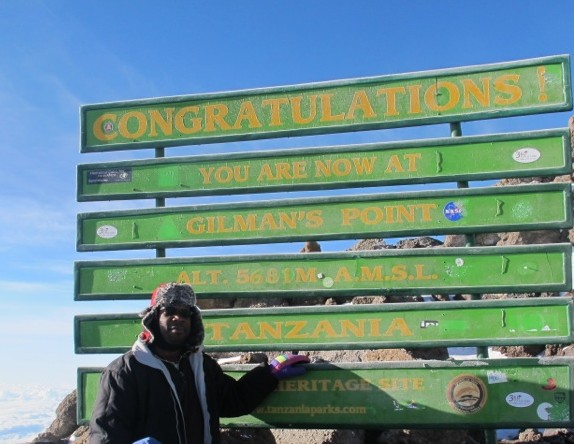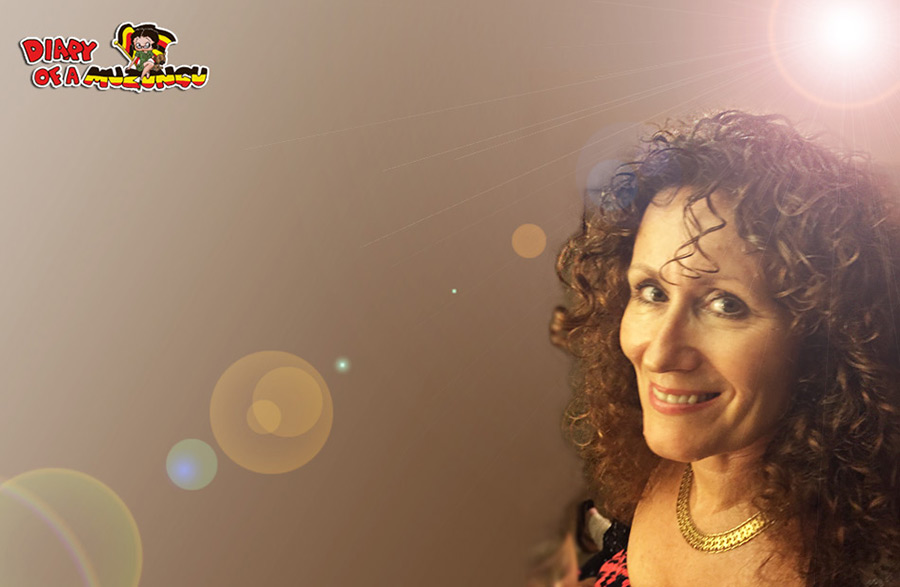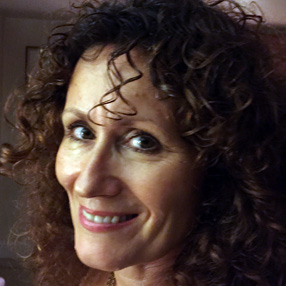
How to climb Mount Kilimanjaro, a personal account by Apollo Makubuya from Uganda.
Is climbing Mount Kilimanjaro on your travel bucket list? I love hiking, but there’s a lot more to it than just being fit, as the Muzungu found out when I climbed (the comparatively low!) Mt. Elgon in Uganda.
Thanks to guest writer Apollo Makubuya for sharing your humbling Kilimanjaro experience! Apollo is a lawyer and fellow Kampala Hash House Harrier. Tales of a Novice Climber was first published in Uganda’s Sunday Vision newspaper. All rights reserved.
Apollo writes:
At the stroke of midnight, we were startled by loud bangs on the door.
It was the mountain guides who excitedly rushed in the dormitory-like room, flashing tiny torches strapped around their heads. John, the chief guide announced it was time to start our final ascent to the summit of Kilimanjaro.
In fact, John’s midnight call shouldn’t have come as a surprise: once we had reached Kibo Base Camp, he had briefed us on what to expect.
Yet, for Isaac and I, the call seemed untimely and invasive. Firstly, because we were exhausted from two days of climbing from Marangu to Mandara and later on to Horombo Base Camps. We were desperate to catch some sleep and to recover. Secondly, because of the high altitude and the cold, I felt sick. In our dreary state, combined with the deep anxiety about the final climb, the lack of sleep and the darkness that surrounded us, the call to get out of bed was sad news – but we had little choice, we had come so far. We also had a deep desire to reach the summit.
Without further procrastination, we had to quickly get up and brace ourselves for the ascent. John’s insistent directives that we “eat or drink more water” floated past us: the only thing we could think of taking was more Panadol.
Surprisingly, once outside, I felt a lot better and ready for the climb. At this stage of our climb up Kilimanjaro, it was just me, Isaac, John and Alan. The rest of the porters were to stay behind and await our return.
Before we set off we huddled and asked God to guide and protect us on this invincible journey.
The idea to climb a mountain was one I have had for some time. I was never clear which mountain it would be.
Once, I’d driven to the base of Mount Meru. This increased my interest in mountains. So, when Diana asked me to join an excursion she was planning to Kilimanjaro, I was quick to say yes, and to recruit Isaac on the team.
The challenges associated with climbing any mountain, let alone Mount Kilimanjaro – especially the need for special climbing gear and training in a high altitude environment – only dawned on me much later.
My casual approach to the affair was partly because I had been physically active in the weeks before the climb. However, as the date for the climb approached and I gathered more information, it was clear that we needed to acquire and carry a whole range of things including woollen hats, upper body layers, fleece jackets, gloves, rain parka, long underwear bottoms, wool pants, rain trousers, tights, heavy wool socks, hiking boots, sleeping bags, head lamps, walking sticks, rucksacks, water bottles and a whole host of ointments and medicines.
While Diana seemed to have her act together, Isaac and I made a last minute effort to get these items in Kampala. The only problem was that no single shop in Kampala sells winter or mountain gear! Our only recourse was to get the stuff from Owino – a downtown second-hand clothes market – via Sula, Isaac’s old friend. Sula’s efforts to find this gear in Kampala were both impressive and hilarious. Impressive – because for about $100 he came up with so many bags, jackets, gloves and woollen hats that you would never expect to be in Uganda. Hilarious – because he bought stuff like bulky full-length woollen jackets that were clearly incompatible with mountain climbing. But, thanks to his efforts, we were saved from the exorbitant rates that the mountain guides charge for the same used items at Moshi.
We set off for Kilimanjaro on Friday and started the climb at Marangu Gate (1,970m) the next day, with a team of ten porters. Led by Albert and John, the porters carried the food, water and cooking equipment necessary for our stay on the mountain. We hikers carried lighter loads – cameras, rain jackets, water and snacks.
On day one we enthusiastically trekked for about four hours through thick montane tropical forest belt from Marangu Gate to Mandara Base Camp. The guides had to occasionally restrain us from moving faster, advising that we should go pole pole i.e. slowly. As some form of initiation or cleansing, we were pelted by rain as soon as we started the trek, so it was a relief to reach Mandara Base Camp (2,700m) late afternoon. The camp, encircled by thick forest alive with Blue Colobus monkeys, was nothing much to write home about; neither was the food – popcorn, biscuits, pasta and cabbage soup – nor the crammed bunk beds in the triangle-shaped green tin-roofed cabins that we shared. For bathing, we were each provided with a small plastic bowl of warm water.
Thus on day two, we were eager to get on with a seven-hour hike that passed through open and scenic heath and moorland of the Kilimanjaro. The vegetation was completely different from the previous day, the route more hilly and jagged. The pace was thus slower and the conversation limited. We crossed several bridges with small rivers rapidly flowing downhill. For the first time we saw the peaks of the mountain in a distance. This increased our adrenaline.
On their descent, we greeted – with a simple Jambo – other climbers and laden porters. Knowing what I know now, some of those Jambo were a form of sympathy for what they knew lay ahead for us. Climbing Kilimanjaro can be a life and death affair. At least ten people die annually trying to climb Mount Kilimanjaro. About 30% of those who attempt it fail because of Acute Mountain Sickness (AMS) that hits randomly – regardless of sex, age or fitness.
The day’s trek ended at Horombo Base Camp (3,720m). Here the temperatures were markedly cooler and the environment more serene. For some reason there was more activity and movement of guards, porters and climbers. As was the routine, we quickly checked into our triangular black-roofed cabin and later to a small dining hall. At dinnertime, Diana declared her wise decision to rest the next day in order to acclimatize more. No amount of persuasion would dissuade her, yet Isaac and I were keen to finish the climb in five days so that we could visit the Ngorongoro Crater before returning home to Kampala. In the end, we sadly agreed to split our team and leave her behind with Albert.
In spite of the exhaustion, I struggled to catch any sleep that night. The tight and unfamiliar sleeping bag did not help.

At about 9.00 a.m. on day three, Isaac and I set our eyes on Kibo Base Camp. John, our new chief guide, set the pace for yet another seven-hour trek. As we moved along we noticed yet another drastic change both in the vegetation and the temperature. At this height we were seeing the clouds below us and it felt as if we were at once floating and walking. Our pace was even slower. The need for the wool jackets, gloves and scarfs was rising. Short and sparse green shrubs and giant alpine palms replaced the lush moorland. The landscape was filled with huge ancient-looking rocks covered with moss. At about 2.00 p.m. we stopped briefly for a sandwich at a place between Mawenzi and Kibo peaks called “The Saddle.”
The hike thereafter was in a barren alpine desert. It was a tough walk in the wilderness. No life, no vegetation at all. All we could see were endless miles of hilly grounds with brown/reddish sandy soils and rocks. A drab sight. The melancholy was heightened by stories of descending climbers who had given-up on the climb and not “summited”. The sight of scampering porters evacuating a dazed climber on a stretcher – also known as the “Kilimanjaro Taxi” – did not help lift our spirits.
By the time we reached Kibo Base Camp (4,700m) we were completely knackered. Staring at us was Gilman’s Point, one of Kilimanjaro’s peaks. The point was so high above us, and the air so windy and hazy, that it was impossible to tell how on earth, we were going to reach the top. Opposite us was the chiselled Mawenzi peak standing at 5,149m. But if the Horombo Camp was cold, the Kibo Camp, perched on top of aged mean-looking rocks, was freezing! In no time we were ushered in and locked up in a dormitory structure. Isaac just crashed on top of his bunk bed in a sleeping bag – complete with shoes, gloves, scarf and jacket. Without any heating, it felt colder in the room than it was outside. I was shivering from deep inside and my head was throbbing. No amount of ginger tea could warm me up. Yet, John had said, we had just a few hours to rest before we started the final climb at midnight.
I did not rest, especially because when the “chef” served us our last meal – before the final ascent, my stomach refused to hold it. So, as I lay nauseated in my sleeping bag, I dreaded the moment that John and the rest would come for us. Many difficult thoughts were whizzing in my mind:
“Shall we make it?
How did I end here?
Could I have prepared myself better?
Will the headache get worse?”

As those thoughts ran in my mind, there were loud knocks on the door. It was John and Co. The moment had arrived. Feeling like a zombie, I sat up and started dressing up in several layers of T-shirts, sweatshirts and a jacket for the upper-body and the same number of layers for the lower body plus Sula’s two pairs of thick knee-high stockings.
The final climb from Kibo Camp to Uhuru (Mount Kilimanjaro’s highest peak) ordinarily takes five hours. The ascent starts at night so that one can see the sunrise from the peak – or so we were told. I suspect though that the real reason for this timing is to avoid the terrifying sight of steep slopes and heights ahead of climbers.
We began the ascent in slow motion, heads bowed, clutching the special walking sticks. For the first few hours, as if in a funeral procession, we moved slowly in the dark and in total silence. It felt eerie. Once we passed the Indian and William Points, completely out of the blue, my stomach stiffened and I started throwing-up again. I sat down to stabilise and got up after a few minutes. Strangely after the episode I felt stronger and got a second wind. In jest, John said “it’s good to get rid of the bad stuff.”
It wasn’t funny.

Far ahead of us we saw moving lights. We thought they were moving stars. But it was another group of climbers using a different route. Although it was good to know that there were others on the trail, we were discouraged because they seemed to move much faster. With stars on my mind, and about three quarters up the mountain, I had another attack. I sat on a rock and went through the motions.
I felt dizzy. John and Isaac were visibly worried. Somehow this scared me more than anything else. I was in their hands. “Was this the dreaded AMS?”
A decision had to be made on whether I should return to the camp. But, AMS or not, returning to the camp was out of the question for me. I convinced myself that I would be ok. Encouraged by my resolve, the rest agreed to continue. Phew!

After this point, our pace reduced drastically, made worse by the snake-like path from the Hans Mayer Point.
We were moving in a zigzag way and making little headway. Every few minutes, we needed to sit down to catch some breath. Strangely Isaac tended to doze off each time he sat down. No amount of glucose could boost my energy levels. On the horizon we saw the sun rising ahead of us yet we had not yet reached the peak. We were behind schedule. The air was very thin and our breathing very hard. There is 50% less oxygen than at sea level here. Gilman Point was almost 100m away. The guides figured it would take us another 30 minutes. We needed to be there before the sun fully came out. The guides must have been irritated by our snail’s pace and constant breaks. In what seemed like an eternity, and after climbing one boulder after another, we literally crawled up to the top of Gilman’s Point (5,681m).
It was a most sobering experience. Isaac there first. John and I followed in a few minutes. Time check was about 6.30 a.m.: it had taken us six and a half hours to reach Gilman’s Point. The sun was fully out.
At the top, I found Isaac motionless on a rock with his head in his hands. The woollen hat covered his face. I wondered what was going on in his mind… He must have fallen asleep! He didn’t seem interested in anything else in the world, not even taking pictures. Apparently his camera had frozen. Thus while it was a moment of accomplishment it was not one of much jubilation. There was no energy for that.
At Gilman’s Point, we saw for the first time the entirety of the snow-capped peak of the Kilimanjaro with its gaping white crater plus the unbelievable glaciers that surrounded us. It was a “wowing” new, white frozen world. I could not take enough pictures and momentarily forgot the exhaustion and pain of getting there. After a few minutes it was time to stand up and get going to the next peak. But Isaac was to have none of that! Enough was enough.
I wanted to continue to the next peaks of Stellar (5,739m) and Uhuru (5,895m) – both of which were within sight – but the thought of leaving my man behind got me confused. So even though we agreed that I continue on my own, after walking a few steps in the snow towards the next peak, my legs became weak and I turned back.
It was an anti-climax.
I felt wholly drained. I soon caught up with Isaac to begin the descent. And what a perilous descent it was!

I cannot count the times each of us fell on the way down.
To increase the pace while saving energy, we tried gliding on some loose gravel but this led to even more falls. At one point Isaac fell and failed to get up. He was sick. It took at least ten minutes for him to revive. Clearly we had not reserved energy for the descent.
And while the Kibo Base Camp was in sight, it was like a mirage; it seemed to get further and further away as we approached it. We finally got there at 11.30 a.m. whereupon John told us to take two-hour rest before we pack up and leave for Horombo – some seven hours away!
Without any options and not wanting to suffer the “Kilimanjaro Taxi,” we left Kibo at about 2.00 p.m. and endured a repeat journey in the wilderness. On the way, we met Diana and Albert and wished them the best with a Jambo! (Both made it successfully to Uhuru the next day).
By the time we got to Horombo, we were finished. It was impossible to imagine how we would make it to Maranga the next day. Thankfully John and his crew negotiated for us to hitch a ride to Moshi town with the mountain guards after we had covered a few miles the next day.
We are lucky to live to tell the tale of an extraordinary, exhilarating and humbling climb to the top of Africa. Jambo!
Thanks Apollo for sharing your amazing experience. Apollo Makubuya is a lawyer and fellow Hash House Harrier. Tales of a Novice Climber was first published in Uganda’s Sunday Vision newspaper. All rights reserved.
Do you have any questions about climbing Kilimanjaro? Looking for a registered tour operator in Tanzania? I recommend SafariBookings.
Mt Kili Madness” – breaking cricket world records at 5,752 metres!
In other news, on 26 September 2014, Mount Kilimanjaro was the setting for the Highest-altitude cricket match, as recorded in the Guinness Book of World Records. “Mt. Kili Madness” was played at 5,752 m (18,871 ft) above sea level, in a dormant volcano crater on Mount Kilimanjaro, Tanzania. Two of the African-based charities that benefit from “Mt. Kili Madness” include the Cricket Builds Hope and Tusk, the wildlife conservation charity.




































Congratulation Muzungu i like your site big up to you from Tanzania.
mustaphamadish.blogspot.com
Really informative and helpful trick for climbing Mount Kilimanjaro. These tips are helpful for the people who are planning for climbing Mount Kilimanjaro. Great thanks for this post, keep sharing.
I really enjoy reading your blog and waiting for your next update. I appreciate all the work you put into this site, helping out others with your services.
Asante sana 🙂
Nice post! Thank you so much for sharing your adventurous and amazing experience with us. This will be helpful for the readers who are looking for some ideas for climbing on Mount Kilimanjaro.
Nice post, it’s totally great with great pictures, Thanks for sharing such a nice topic with us. Appreciate your work
Thank you so much for sharing these tips for climbing Mount Kilimanjaro. This will definitely helpful for the tourist who is interesting to climb Mount Kilimanjaro.